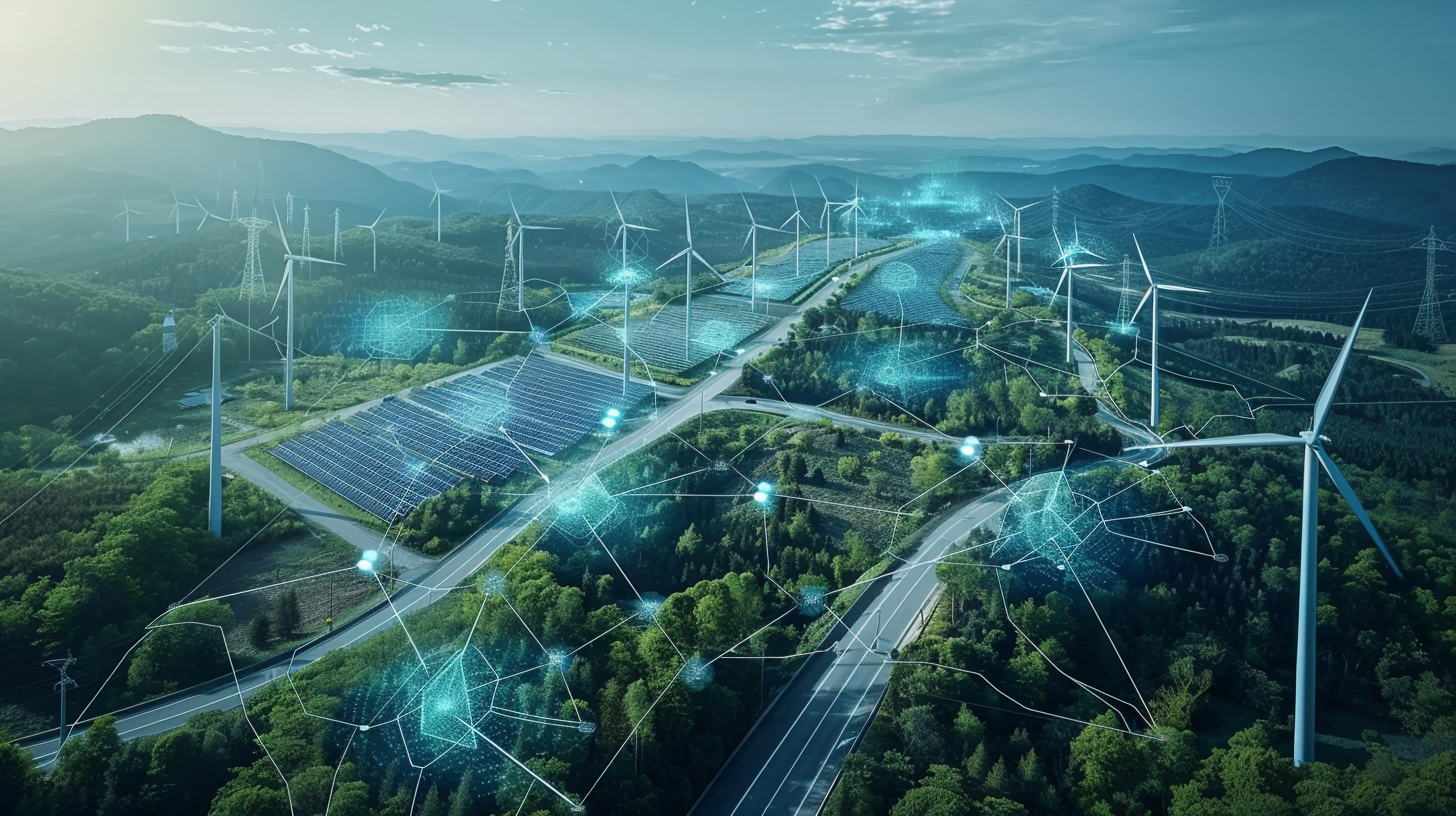Grid Edge Integration: The Key to Building a More Sustainable Power Grid

Source: Alpha/stock.adobe.com; generated with AI
Our current grid excels at delivering power across long distances, but it wasn't designed for the variable flow of renewable energy. We spoke to Jaime Kolln, senior power system engineer at Pacific Northwest National Laboratory (PNNL), about key technologies that enable the monitoring and control required to incorporate fluctuating energy sources. Moreover, we learned how integrating these technologies at the grid edge is fundamental to decentralizing energy management and creating a more stable grid for all.

Jaime Kolln is a Senior Power System Engineer at Pacific Northwest National Laboratory (PNNL) working in the field of grid architecture, primarily on system integration and grid edge interoperability. He is responsible for research in the areas of distributed energy technology, power system communications, energy storage, transportation electrification, and distributed control solutions.
Mouser Electronics: Thanks for joining me, Jaime. What led you to work with smart grids?
Jaime Kolln: I’ve always been fascinated by systems integration and controls, beginning my career working with home theater systems, alarms, and lighting. This led me to complete an electrical engineering degree at Portland State University, where a mentor sparked my passion for power systems and distributed energy resources (DERs). I’ve been at PNNL for nearly six years and have gone from working on connected homes, integrating buildings to be presented as grid assets, to grid edge integration, dealing with technologies at the grid's edge, such as transportation electrification and stationary storage. This means integrating electric vehicles (EVs), which can both draw from and supply power to the grid, and stationary storage systems like batteries that store excess energy for later use.
Technologies for Renewable Energy Integration
What technologies are crucial to renewable energy integration?
Energy storage is essential for electrification across various applications, from EVs to home energy management; they act as buffers, storing excess energy when production is high and supplying power when demand increases or production drops. Inverters, on the other hand, are sophisticated devices that play a critical role in managing the flow of electricity.
Can you elaborate on how these inverters function?
Certainly. Inverters are critical to the integration of renewable energy onto the grid. Traditional inverters convert direct current (DC), like that which comes from solar panels, into alternating current (AC), which is what we use to power the loads in our homes and businesses. Advanced four-quadrant inverters go a step further, converting energy and dynamically managing real and reactive power. Imagine you have a home with solar panels and a battery or EV. When the sun is shining, these panels generate electricity. These advanced inverters can aid in charging and discharging, adjusting how much electricity goes into powering your home and how much gets fed back into the grid. Four-quadrant inverters can import and export real and reactive power, helping to balance the electric grid, which previously required centralized generators and controls. Additionally, they can be used to support voltage and frequency, which is essential to grid stability.
They benefit both the grid as a whole and individuals?
Absolutely. Having robust grid infrastructure with advanced inverters means improved reliability and resilience against power outages. For instance, during extreme weather events, communities with solar and battery storage can continue to function independently, ensuring critical services remain operational.
Systems to Improve Grid Edge Integration
How do technologies such as batteries and inverters interact at the grid edge?
Good question. The decentralized nature of modern energy systems requires sophisticated control and real-time responsiveness. So, at the grid edge, we need mechanisms to optimize interactions between these technologies. We’ve been developing transactive energy systems to facilitate this, ensuring that batteries and inverters can effectively balance supply and demand by responding to real-time price signals and optimizing energy flows.
What are transactive energy systems? Transactive energy systems facilitate real-time price and value signals to coordinate DERs, allowing [them] to respond dynamically to grid conditions. It’s like an energy stock exchange happening in real time. They use dynamic pricing signals to incentivize devices like your smart thermostat. During peak demand, the grid might offer a better rate if you delay running your air conditioner for a bit, empowering you to participate in managing the grid while saving money on your electricity bill.
And are transactive energy systems feasible in reality?
In theory, yes. During the Distribution System Operator with Transactive program, (1) we modeled the entire Electric Reliability Council of Texas (ERCOT) power system. The program was a significant undertaking, involving sophisticated computer modeling to simulate different levels of DER penetration.
And what were the outcomes of the program?
The program detailed how DERs could participate effectively in a transactive energy market by identifying technical requirements and economic benefits. It highlighted the need for greater visibility and data integration by operators to manage and optimize the grid. One of the most valuable insights was how grid services could be structured to facilitate energy exchange at the local level, similar to how wholesale power markets operate. This groundwork supports future pilot projects, proving the feasibility and benefits of transactive energy systems.
How do you ensure that these diverse systems communicate effectively?
Interoperability is key. I'm the administrator of the GridWise Architecture Council (GWAC), where we work to promote transactive energy and interoperability concepts. This work has been foundational to our work to create the Energy Services Interface, standardizing device interactions with the grid to reduce integration costs and complexity.
What about integrating with legacy systems?
We work on exciting pilot projects at PNNL that directly address this challenge. For example, in the Olympic Peninsula Smart Grid Demonstration Project, we partnered with local utilities and industry leaders to send price signals directly to customer thermostats and water heaters. This initiative empowered these devices to autonomously adjust usage based on real-time grid needs and customer preferences. These efforts validate new technologies and pave the way for their effective integration with existing grid infrastructure.
The Future Decentralized Energy Market
What are the main obstacles to wider adoption?
The biggest challenges are user acceptance and policy. Many utilities are cautious about adopting new technologies without proof of their reliability and cost-effectiveness. Cybersecurity is also a significant concern as we integrate more customer-owned assets.
What regulatory barriers exist?
Regulation has traditionally supported centralized generation from a utility-centric perspective. Utilities might focus more on managing the wires while the energy market becomes more decentralized and participatory. Experts recommend national standards are needed to streamline integration rather than having 3,000 utilities with different requirements. For instance, they’ve implemented time-of-use rates in California to manage demand and supply more effectively. However, these rates have limitations as the number of distributed energy resources increases; if people tend to respond simultaneously, it could cause voltage rippling and other technical challenges.
Looking ahead, how do you see grid edge integration evolving?
The future is a collaborative effort involving advanced technology, thoughtful policy development, and user engagement. But by working together, I’m confident we can unlock the power of transactive energy systems to create a decentralized energy market. Imagine your neighborhood empowered to optimize energy usage, leading to a more resilient and sustainable grid for everyone. It's a bright future, and I’m excited to be working on the technologies and strategies that will make it a reality.
Jaime, we have much to consider. Thank you so much for sharing your insights today.
The pleasure is all mine.
Conclusion
Kolln’s insights highlight the transformative potential of smart grid technologies. Components like batteries and inverters ensure renewable energy balance and grid stability. Meanwhile, effective smart grid integration relies on sophisticated control systems and robust interoperability standards. With evolving policies and active user engagement, smart grid integration through transactive energy systems could pave the way for a decentralized energy market—empowering communities to optimize energy usage and, ultimately, building a smarter power grid for all.
(1 )https://www.pnnl.gov/projects/transactive-systems-program/dsot-study